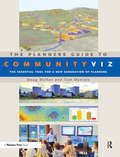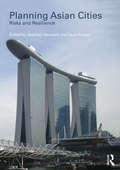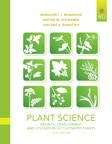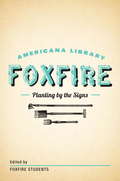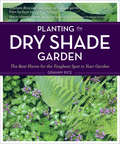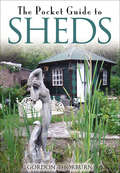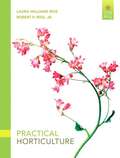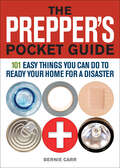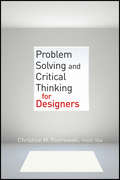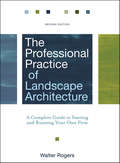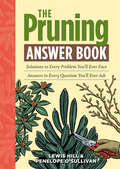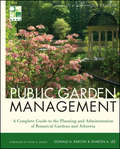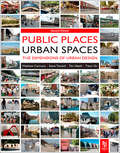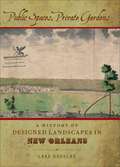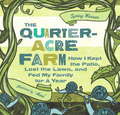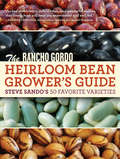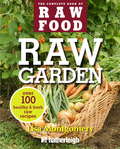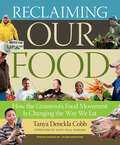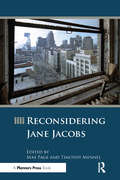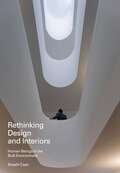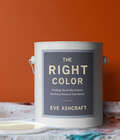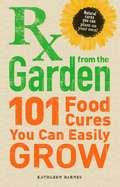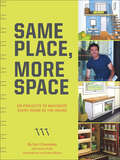- Table View
- List View
The Planners Guide to CommunityViz: The Essential Tool for a New Generation of Planning
by Doug WalkerWhat does the future look like? Planners wrestle with this question daily as they strive to bring a community's vision of itself to life, in all its complexity. Here is an authoritative and accessible guide to a tool that combines 3-D visualization, data analysis and scenario building to let planners and citizens see the future impacts of a plan or development. The Planners Guide to CommunityViz is the first book to explain how to support planning projects with CommunityViz, GIS-based software that planners around the world are using to help decision-makers, professionals, and the public visualize, analyze, and communicate about development proposals, future growth patterns, and the outcome of particular plans or developments. It shows the planner which tools and techniques to use and how to use them for maximum effectiveness on planning projects large and small. Full of practical examples and case studies, the book shows how CommunityViz can enliven the comprehensive planning process from visioning, to public participation, to values mapping, to build-out analysis. Chapters show how to use CommunityViz to analyze zoning regulations, calculate the costs of community services, and evaluate development proposals requiring design review. In addition, it is applicable to transportation planning, natural-resource planning, land-development suitability assessment, and urban economic development analysis.
Planning Asian Cities: Risks and Resilience (Planning, History and Environment Series)
by Stephen Hamnett Dean ForbesIn Planning Asian Cities: Risks and Resilience, Stephen Hamnett and Dean Forbes have brought together some of the region’s most distinguished urbanists to explore the planning history and recent development of Pacific Asia’s major cities. They show how globalization, and the competition to achieve global city status, has had a profound effect on all these cities. Tokyo is an archetypal world city. Singapore, Hong Kong and Seoul have acquired world city characteristics. Taipei and Kuala Lumpur have been at the centre of expanding economies in which nationalism and global aspirations have been intertwined and expressed in the built environment. Beijing, Hong Kong and Shanghai have played key, sometimes competing, roles in China’s rapid economic growth. Bangkok’s amenity economy is currently threatened by political instability, while Jakarta and Manila are the core city-regions of less developed countries with sluggish economies and significant unrealized potential. But how resilient are these cities to the risks that they face? How can they manage continuing pressures for development and growth while reducing their vulnerability to a range of potential crises? How well prepared are they for climate change? How can they build social capital, so important to a city’s recovery from shocks and disasters? What forms of governance and planning are appropriate for the vast mega-regions that are emerging? And, given the tradition of top-down, centralized, state-directed planning which drove the economic growth of many of these cities in the last century, what prospects are there of them becoming more inclusive and sensitive to the diverse needs of their populations and to the importance of culture, heritage and local places in creating liveable cities?
Plant Science: Growth, Development, and Utilization of Cultivated Plants
by Margaret E. Mcmahon Anton M. Kofranek Vincent E. RubatzkyPlant Science: Growth, Development, and Utilization of Cultivated Plants, Fifth Edition, is an outstanding resource for anyone with an interest in how plants are grown and utilized for maintaining and adding enjoyment to human life. The text starts with the fundamentals of botany, plant physiology, and environmental factors affecting plant growth, while later sections integrate those topics into strategies of producing plants for human use as food, fiber, and recreation. The concept of sustainability and sustainable methods of growing plants runs throughout the text. Whether you are familiar or unfamiliar with plant science, this book will give you a firm understanding of concepts and terminology related to the growing of plants.
Planting By the Signs: The Foxfire Americana Library (10) (The Foxfire Americana Library)
by Inc. Foxfire FundAn Appalachian farmer's almanac, "Planting by the Signs" is a valuable resource for the gardener looking for time-honored tips for clearing land and growing vegetables from the people who originally pioneered the art through hard work (and a little bit of luck). In the spirit of the Foxfire Americana Library, this entry also contains a collection of gardening-related folklore, including signs to tell that winter is coming and a guide to planting successfully according to the stars.
Planting the Dry Shade Garden: The Best Plants for the Toughest Spot in Your Garden
by Graham RiceIn this book you'll learn how to prune selectively to admit more light and how to amend soil to increase its moisture retention. You'll also learn about more than 130 plants that accept reduced light and moisture levels-long-blooming woodland gems like epimediums and hellebores, and even lush foliage plants like evergreen ferns and hardy gingers, shrubs, climbers, perennials, ground covers, bulbs, annuals, and perennials- there is an entire palette to help you transform challenging spaces into rich, rewarding gardens.
The Pocket Guide to Sheds
by Gordon ThorburnAs the globe warms, everything runs out and people become the willing slaves of small electronic machines, we have our response: the Golden Age of Sheds. We can look out from our sheds and see those unfortunates, the slaves in question, the ones who would rather be stripped naked and whipped through the market square than be separated, for one nanosecond, from their portable telephones and i-thingies, and we can smile.This book is where the smilers are. Here, you can find the man who reinvigorates the entente cordiale in wood, the woman who boils kettles, the woman who says 'I'm Nicola from In the Shed', the man who says 'What's yours?', the dooket that Jock built, the blockhouse that Noah built, a neoclassical stately home, and all manner of things musical, yogic, animalcular, roguish, ockerish and cloudy. Whether we see our shed as a place of work, a place of fun, a welcome refuge from normality, a shaded pool of tranquility, a realization of a secret yearning, a place to pot up the geraniums, or a little bit of all those things combined, we Sheddies, tribesfolk of the mighty Sheddici, hold one truth to be undeniable. We have our sheds, and the others haven't.
Practical Horticulture
by Laura Rice Robert RicePractical Horticulture, Seventh Edition, is a classic, scientifically oriented book for basic horticulture. It presents readers with the fundamentals of horticultural science and its applications in both the commercial and home sectors. Easy-to-read, the books’s ample illustrations, chapter objectives, and chapter-ending review questions, help readers learn the concepts. Some exciting new features to this edition include: Updated with timely coverage of hot environmental topics. The latest information on horticultural science for indoor and outdoor plants. A new chapter on careers in horticulture has been added. This is a great resource for anyone interested in horticulture!
The Prepper's Pocket Guide: 101 Easy Things You Can Do to Ready Your Home for a Disaster (Preppers Ser.)
by Bernie Carr Evan WondolowskiBE PREPAREDBE SAFEFrom California earthquakes and Rocky Mountain wildfires to Midwest floods and Atlantic hurricanes, you can't escape that inevitable day when catastrophe strikes your home town - but you can be prepared! Offering a simple DIY approach, this book breaks down the vital steps you should take into 101 quick, smart and inexpensive projects: #6 Make a Master List of Passwords#16 Calculate How Much Water You Need#33 Start a Food Storage Plan for $5 a Week#60 Make a Safe from a Hollowed-out Book#77 Assemble an Inexpensive First Aid kit#89 Learn to Cook Without Electricity#94 Pack a Bug-out Bag
Problem Solving and Critical Thinking for Designers
by Christine M. PiotrowskiThe essential guide to decision making and problem solving for the interior designer The interior design profession requires effective problem solving and critical thinking, as they impact all phases of the design project and most work activities of the interior designer. Whether you are a student or professional designer, much of what you do involves these skills. Although most of us do not even think about what we do in terms of these activities, they are a constant part of design. They are also skills that must be performed successfully outside a professional career. Improving these skills makes you a more sought-after employee and designer, effective business owner, and fulfilled individual. Problem Solving and Critical Thinking for Designers will put the reader on the correct path to a solutions-oriented practice. Using her trademark accessible and conversational approach, Christine Piotrowski guides readers through the process of how the working designer solves problems and makes decisions. Some of the topics she discusses are: Design process Communication Asking questions Problem definition and analysis Decision-making process Negotiation Working with others Ethical decision making This book also features real-life scenarios and design problems that guide the reader toward making correct decisions in real-life situations.
The Professional Practice of Landscape Architecture
by Walter Rogers Michaal DollinThe all-inclusive reference to starting and operating a landscape architecture firm The Professional Practice of Landscape Architecture, Second Edition is completely revised to keep up with the latest developments driving the day-to-day operation of a successful private-practice landscape architecture office. Whether helping a landscape architecture student identify a career track, providing direction on starting a new office, guiding an owner seeking to jumpstart a stagnant or fledgling business, or assisting a landscape architect-in-training study for the national Landscape Architecture Registration Exam (LARE), this single-source blueprint is the key to prospering in this dynamic field. This new edition features: Indispensible information for practicing landscape architects, including professional ethics, finances, office administration, marketing and promotion, and project management An updated look at government regulatory laws, federal tax administration, sustainable design, and LEED certification Strategies for using the Internet, computer software, and technology to market and manage a firm Examples of professional contract templates Case study profiles of landscape architecture firms Requirements for professional registration and criteria for taking the national exam This comprehensive and practical reference combines real-world experience with the highest professional standards to instruct the reader on business concepts. Expertly organized and easy to follow, The Professional Practice of Landscape Architecture, Second Edition continues to be the one source that landscape architects need to direct all facets of their practice.
The Pruning Answer Book: Solutions to Every Problem You'll Ever Face; Answers to Every Question You'll Ever Ask (Answer Book Ser.)
by Lewis Hill Penelope O'SullivanWhen should you prune a blackberry bush? How much should you remove? What’s the difference between pinching and heading back? And how can you be sure that you aren’t harming your fragile blossoms? The Pruning Answer Book offers fresh insights to these relevant questions and scores of others. With clear instructions, detailed illustrations, and expert advice, you’ll have all the information you need to successfully prune flowering plants, fruit and nut trees, shrubs, brambles, evergreens, vines, groundcovers, and more.
Public Garden Management
by Donald A. Rakow Sharon A. LeeThe complete-and-ready reference for establishing, managing, and running a successful and sustainable, profitable public garden As unique museums with living collections of plants, public gardens offer visitors aesthetically beautiful landscapes combined with educational programming and scientific research that promote the value and understanding of plants. In the twenty-first century, public gardens are in the forefront of organizations and institutions committed to promoting the conservation of plants and their habitats, developing sustainable practices that support the environment, and providing green spaces where our increasingly stressed and urbanized citizens can reconnect with the natural world. It is critically important that such institutions have trained, knowledgeable staff members. Because of its comprehensive examination of public gardens, Public Garden Management is the ideal guide for staff members at public gardens, anyone considering a career in public gardens, groups starting a botanical garden or arboretum, and students discovering how these complex institutions work. Public Garden Management is an all-in-one professional reference and textbook that clearly shows how to develop, establish, manage, and maintain a sustainable-both economically and environmentally-public garden. Offering practical coverage of relevant topics, along with useful tools for reinforcing study, this insightful and forward-thinking guide is: Copublished by the American Public Gardens Association Written by a panel of leading experts in the field Filled with dozens of case studies that are real-world illustrations of the principles explored in the text Illustrated throughout with line drawings, figures, and photographs that assist in conveying critical information Students and professionals will benefit greatly from the management principles outlined in this book, helping them establish and maintain new and existing public gardens that engage, inspire, and connect with their communities.
Public Places - Urban Spaces
by Tim Heath Taner Oc Steve TiesdellPublic Places Urban Spaces, 2e, is a thorough introduction to the principles of urban design theory and practice. Authored by experts in the fields of urban design and planning, it is designed specifically for the 2,500 postgraduate students on Urban Design courses in the UK, and 1,500 students on undergraduate courses in the same subject.The 2e of this tried and trusted textbook has been updated with relevant case studies to show students how principles have been put into practice. The book is now in full color and in a larger format, so students and lecturers get a much stronger visual package and easy-to-use layout, enabling them to more easily practically apply principles of urban design to their projects.Sustainability is the driving factor in urban regeneration and new urban development, and the new edition is focused on best sustainable design and practice. Public Places Urban Spaces is a must-have purchase for those on urban design courses and for professionals who want to update and refresh their knowledge.
Public Spaces, Private Gardens: A History of Designed Landscapes in New Orleans
by Lake DouglasLandscape architect Lake Douglas employs written accounts, archival data, historic photographs, lithographs, maps, and city planning documents -- many of which have never before been published -- to explore public and private outdoor spaces in New Orleans and those who shaped them. The result offers the first in-depth examination of the city's landscape history.Douglas presents this "beautiful and imposing" city as a work of art crafted by numerous influences. His survey from the colonial period to the twentieth century finds that geography, climate, and, above all, the multicultural character of its residents have made New Orleans unique in American landscape design history. French and Spanish settlers, Africans and Native Americans, as well as immigrants from Germany, Ireland, Italy, and other parts of the world all participated in creating this community's unique public and private landscapes. Places such as Congo Square, Audubon Park, the river levees, and "neutral grounds" -- local residents' own term for medians -- together with ordinary residential gardens are all testaments to the city's international imprint. Douglas identifies five types of public and private designed landscapes in New Orleans: squares, linear open spaces, urban parks, commercial pleasure gardens, and domestic gardens. Discussing their design, function, and content, he shows how specific examples of each contribute to the city's unique character and also fit within the larger context of American landscape design history. Each type has its own complexion and reflects the influence of those who occupied it. Though New Orleanians lived in strata according to language, cultural identity, economics, and race, they found common ground, literally, in their community's landscapes.Douglas's sweeping study, illustrated with over 90 color and black-and-white images, includes an exploration of archival horticultural books, almanacs, and periodicals; information about laborers who actually built landscapes; details of horticultural commerce, services, and marketing materials; and an exhaustive inventory of plants grown in New Orleans for agricultural, medicinal, and ornamental uses.Public Spaces, Private Gardens provides an informative look at two hundred years of the designed landscapes and horticulture of New Orleans and a fresh perspective on one of America's most interesting and historic cities.
The Quarter-Acre Farm: How I Kept the Patio, Lost the Lawn, and Fed My Family for a Year
by Jesse Pruet Spring WarrenWhen Spring Warren told her husband and two teenage boys that she wanted to grow 75 percent of all the food they consumed for one year-and that she wanted to do it in their yard-they told her she was crazy.She did it anyway.The Quarter-Acre Farm is Warren's account of deciding-despite all resistance-to take control of her family's food choices, get her hands dirty, and create a garden in her suburban yard. It's a story of bugs, worms, rot, and failure; of learning, replanting, harvesting, and eating. The road is long and riddled with mistakes, but by the end of her yearlong experiment, Warren's sons and husband have become her biggest fans-in fact, they're even eager to help harvest (and eat) the beautiful bounty she brings in.Full of tips and recipes to help anyone interested in growing and preparing at least a small part of their diet at home, The Quarter-Acre Farm is a warm, witty tale about family, food, and the incredible gratification that accompanies self-sufficiency.
The Rancho Gordo Heirloom Bean Grower's Guide: Steve Sando's 50 Favorite Varieties
by Steve SandoSteve Sando founded Rancho Gordo with the simple idea that saving our New World foods is a critical pursuit, and his passion for heirloom beans has made his business a huge success. Sando’s beans are sought after by famous chefs like Thomas Keller (Vallarta is his favorite), and he’s frequently profiled in publications such as Bon Appetit, Saveur, and the New York Times.In The Rancho Gordo Heirloom Bean Grower's Guide, Sando invites the gardener and home cook to share his passion, profiling the fifty best beans to grow, cook, and save. From the silky flavor of Good Mother Stallard to the buttery Runner Cannellinis, the most delicious varieties are presented in these pages along with growing tips, flavor notes, stories of their heritage, and beautiful photographs that showcase the unique beauty of each bean. In reintroducing the best of the New World heirloom beans, Sando has created a sensation, and food-lovers everywhere will relish transforming this humble staple into a celebrated delicacy.
Raw Garden: Over 100 Healthy and Fresh Raw Recipes
by Lisa MontgomeryGet the most out of your garden with these delicious raw food recipes!If you love growing your own fruits and vegetables, but are unsure how to start using your harvest, now is your chance to learn. Whether you're new to gardening or have been doing it for years, Raw Garden is the perfect resource to help you create dishes based on ingredients found in your garden by sharing simple, delicious raw food recipes for you to try. From salads and snacks, to main dishes and desserts, Raw Garden has some of the best raw food recipes you can find.Some of the over 100 delicious and creative recipes featured in Raw Garden include Curry Carrot Salad, Cranberry Walnut Coleslaw, Southwestern Stuffed Avocadoes, Goji Coconut Cream Sauce, Pine Nut Parmesan, Turkey Nut Burgers, Sea Spaghetti Alfredo, Banana Ice Cream, Pineapple Salsa, and much more!Packed with lots of practical and helpful information, Raw Garden also includes:* Tips on planning your garden* Benefits of growing and eating raw food* How to garden in small living spaces* A guide to the art of bee- and chicken-keepingWith unique and exciting raw recipes, Raw Garden is sure to bring your gardening, and your meals, to new heights!
Reclaiming Our Food: How the Grassroots Food Movement Is Changing the Way We Eat
by Tanya Denckla CobbReclaiming Our Food tells the stories of people across the United States who are finding new ways to grow, process, and distribute food for their own communities. Discover how abandoned urban lots have been turned into productive organic farms, how a family-run sustainable fish farm can stay local and be profitable, and how engaged communities are bringing fresh produce into school cafeterias. Through photographic essays and interviews with innovative food leaders, you’ll be inspired to get involved and help cultivate your own local food economy.
Reconsidering Jane Jacobs
by Max Page Timothy MennelThis volume begins with the premise that the deepest respect is shown through honest critique. One of the greatest problems in understanding the influence of the author on cities and planning is that she has for much of the past five decades been "Saint Jane, the housewife" who upended urban renewal and gave us back our cities. Over time, she has become a saintly stick figure, a font of simple wisdom for urban health that allows many to recite her ideas and few to understand their complexity. The author has been the victim of her own success. This book gives this important thinker the respect she deserves, reminding planning professionals of the full range and complexity of her ideas and offering thoughtful critiques on the unintended consequences of her ideas on cities and planning today. It also looks at the international relevance – or lack thereof – of her work, with essays on urbanism in Abu Dhabi, Argentina, China, the Netherlands, and elsewhere.
Residential Interior Design
by Maureen Mitton Courtney NystuenThe completely revised room-by-room guide to home interior designResidential Interior Design, Second Edition teaches the fundamental skills that are needed to plan interior spaces for all types of homes, regardless of decorative styles, from remodeling to new construction. Taking a step-by-step approach, this valuable primer reviews all aspects of interior architecture as it relates to human factors and daily use.Authors Maureen Mitton and Courtney Nystuen explore the minimal amount of space that is necessary for rooms to function usefully, from the kitchen to the bathroom, the bedroom to the hallway, and every room in between. Packed with hundreds of drawings and photographs, this valuable tool is brimming with useful information regarding codes, mechanical and electrical systems, keys to creating wheelchair accessible spaces, and a variety of additional factors that impact each type of room and its corresponding space. Now featuring a companion website with instructor resources, this new edition is:Revised and updated with new building codes information and expanded information on sustainability, building construction, doors, windows, home offices, and outdoor spacesIllustrated throughout with line drawings and photographs to clearly explain the concepts coveredThe perfect study aid for the NCIDQ examWith a focus on quality of design over quantity of space, Residential Interior Design, Second Edition is the first stop to designing equally efficient and attractive rooms.
Rethinking Design and Interiors: Human Beings In The Built Environment
by Shashi CaanThe world and the people living in it are increasingly and rapidly being affected by environmental and technological changes. It is imperative that the design profession addresses these developments with a new way of thinking. This book points the way for the design of interiors in this newly complex world and will be indispensable for students, practitioners and theoreticians.The book is divided into four chapters that explore aspects of the human experience of the interior, from man’s earliest search for shelter to an outline of past and current thinking on design, psychology and well-being. An epilogue looks at such future concerns as population growth and sustainability and suggests how the design profession can confront these challenges.Rethinking Design and Interiors is a fascinating exploration of how art and science can come together for the benefit of those who inhabit the built environment.
Rethinking Design and Interiors: Human Beings in the Built Environment
by Shashi CaanThe world and the people living in it are increasingly and rapidly being affected by environmental and technological changes. It is imperative that the design profession addresses these developments with a new way of thinking. This book points the way for the design of interiors in this newly complex world and will be indispensable for students, practitioners and theoreticians.The book is divided into four chapters that explore aspects of the human experience of the interior, from man’s earliest search for shelter to an outline of past and current thinking on design, psychology and well-being. An epilogue looks at such future concerns as population growth and sustainability and suggests how the design profession can confront these challenges.Rethinking Design and Interiors is a fascinating exploration of how art and science can come together for the benefit of those who inhabit the built environment.
The Right Color
by Eve AshcraftThe definitive guide to paint by the nation’s most sought-after color consultantWhen Martha Stewart was developing her first paint collection, the Araucana Colors (based on the hues of her chickens’ eggs), she turned to the nation’s top color consultant: Eve Ashcraft. Eve helped Martha to pinpoint the colors of that enormously successful paint line, thus assisting in transforming an industry along the way. In her first book, The Right Color, her own curated palette (her paint line launches this fall) and countless other favorite shades and color combinations provide inspiration for every room in the house. Packed with trade secrets, such as how to make a small room look bigger, how to use color to brighten a space, and how to use paint to resolve myriad architectural challenges, this book will give anyone the confidence to choose a palette that will make the most of any space.
Rx from the Garden: 101 Food Cures You Can Easily Grow
by Kathleen BarnesYour backyard becomes an all-natural pharmacy!Colds. Headaches. Upset stomach, Allergy symptoms. Depression. Circulation problems.This timely book goes beyond using herbs as medicine; it also focuses on beneficial foods for more than 100 common ailments and shows you how to grow them.In that way, RX from the Garden lets you circumvent expensive meds with questionable side effects by explaining what foods to eat to help you feel better. In addition to aligning health problems with natural cures, this valuable resource provides step-by-step instruction on how to easily cultivate the corresponding vegetables and herbs in your lawn, garden, or flowerbed.According to Hippocrates, "Our food should be our medicine. Our medicine should be our food." Now you can reap health benefits for your very own backyard bounty.
Same Place, More Space: 50 Projects to Maximize Every Room in the House
by Arthur Mount Karen Kelly Karl ChampleyMaster carpenter and DIY Network host Karl Champley offers 50 home improvement projects to maximize space in any dwelling, no matter how big or small. Keeping an eye on style and economy, Champley outlines tools, materials, and techniques for searching out and using hidden-away space to achieve incredible results. Readers will learn how to carve out shelving niches between studs in the wall, tuck more into kitchen cupboards, build hidey-holes beneath floor boards, and much more. The projects range from easy organization solutions to weekend construction projects and more ambitious undertakings. With easy-to-follow instructions for making more out of less, detailed illustrations, and no-nonsense advice on clutter control, Same Place, More Space makes it simple to create a more functional, expansive, and beautiful home without moving or remodeling.
